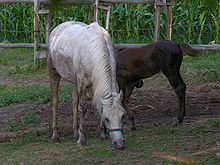
Lord Morton's mare
Encyclopedia

In 1821 George Douglas, 16th Earl of Morton
George Douglas, 16th Earl of Morton
George Douglas, 16th Earl of Morton, KT was the son of Sholto Douglas, 15th Earl of Morton.He was elected a Fellow of the Royal Society in February, 1785 and served as their vice-president from 1795-1819...
, F.R.S., reported to the President of the Royal Society
Royal Society
The Royal Society of London for Improving Natural Knowledge, known simply as the Royal Society, is a learned society for science, and is possibly the oldest such society in existence. Founded in November 1660, it was granted a Royal Charter by King Charles II as the "Royal Society of London"...
that being desirous of domesticating the quagga
Quagga
The quagga is an extinct subspecies of the plains zebra, which was once found in great numbers in South Africa's Cape Province and the southern part of the Orange Free State. It was distinguished from other zebras by having the usual vivid marks on the front part of the body only...
, he had bred an Arabian chestnut mare with a quagga stallion
Stallion (horse)
A stallion is a male horse that has not been gelded .Stallions will follow the conformation and phenotype of their breed, but within that standard, the presence of hormones such as testosterone may give stallions a thicker, "cresty" neck, as well as a somewhat more muscular physique as compared to...
, and that subsequently Lord Morton bred the same mare
Mare (horse)
A mare is an adult female horse or other equine.In most cases, a mare is a female horse over the age of three, and a filly is a female horse age three and younger. However, in Thoroughbred horse racing, a mare is defined as a female horse more than four years old; in harness racing a mare is a...
with a white stallion and found that the offspring
Offspring
In biology, offspring is the product of reproduction, of a new organism produced by one or more parents.Collective offspring may be known as a brood or progeny in a more general way...
had strange stripes in the legs, like the quagga. The Royal Society published Lord Morton's letter in its Philosophical Transactions, 1821. In the same issue "Particulars of a Fact, nearly similar to that related by Lord Morton, communicated to the President, in a letter from Daniel Giles, Esq." reported that in a litter of a black and white sow, by a "boar of the wild breed, the chestnut colour of the boar strongly prevailed" in the piglets, even to the third subsequent litter.
These circumstantial reports seemed to confirm the ancient idea of telegony
Telegony (pregnancy)
Telegony is a theory in heredity, now discredited but widely believed until the late 19th century, holding that offspring can inherit the characteristics of a previous mate of the female parent; thus the child of a widowed or remarried woman might partake of traits of a previous husband...
in heritability: Charles Darwin
Charles Darwin
Charles Robert Darwin FRS was an English naturalist. He established that all species of life have descended over time from common ancestry, and proposed the scientific theory that this branching pattern of evolution resulted from a process that he called natural selection.He published his theory...
cited the example in On the Origin of Species (1859) and The Variation of Animals and Plants under Domestication
The Variation of Animals and Plants under Domestication
The Variation of Animals and Plants under Domestication is a book written by Charles Darwin that was first published in January 1868.A large proportion of the book contains detailed information on the domestication of animals and plants but it also contains in Chapter XXVII a description of...
(1868). The concept of telegony, that the seed of a male could continue to affect the offspring of a female, whether animal or human, had been inherited from Aristotle
Aristotle
Aristotle was a Greek philosopher and polymath, a student of Plato and teacher of Alexander the Great. His writings cover many subjects, including physics, metaphysics, poetry, theater, music, logic, rhetoric, linguistics, politics, government, ethics, biology, and zoology...
and remained a legitimate theory until experiments in the 1890s confirmed Mendelian inheritance
Mendelian inheritance
Mendelian inheritance is a scientific description of how hereditary characteristics are passed from parent organisms to their offspring; it underlies much of genetics...
. Biologists now explain the phenomenon of Lord Morton's mare using dominant and recessive allele
Allele
An allele is one of two or more forms of a gene or a genetic locus . "Allel" is an abbreviation of allelomorph. Sometimes, different alleles can result in different observable phenotypic traits, such as different pigmentation...
s.

